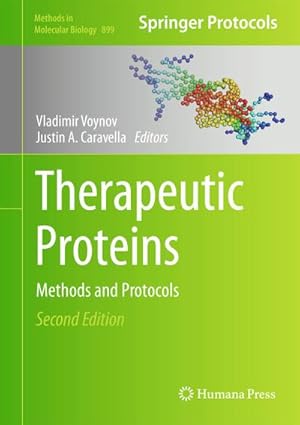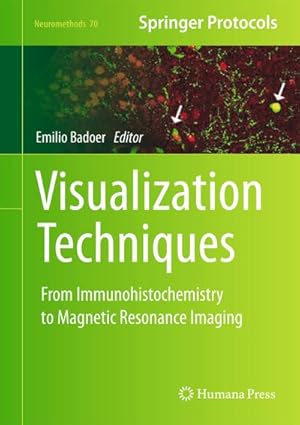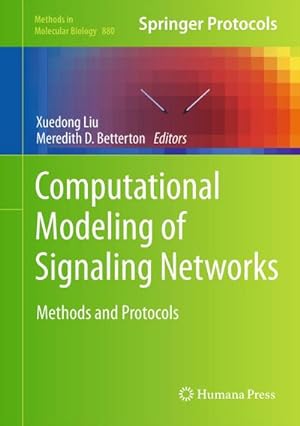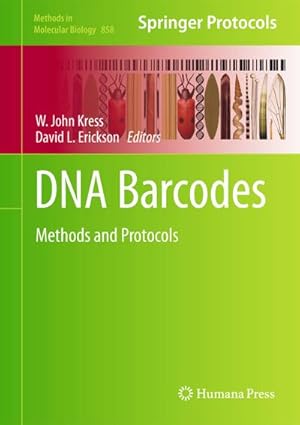humana press jun 2012 (18 results)
Product Type
- All Product Types
- Books (18)
- Magazines & Periodicals
- Comics
- Sheet Music
- Art, Prints & Posters
- Photographs
- Maps
-
Manuscripts &
Paper Collectibles
Condition
- All Conditions
- New
- Used
Binding
- All Bindings
- Hardcover
- Softcover
Collectible Attributes
- First Edition
- Signed
- Dust Jacket
- Seller-Supplied Images
- Not Printed On Demand
Seller Location
Seller Rating
-
Receptor Binding Techniques
Published by Humana Press Jun 2012, 2012
ISBN 10: 1617799084ISBN 13: 9781617799082
Seller: BuchWeltWeit Ludwig Meier e.K., Bergisch Gladbach, Germany
Book Print on Demand
Buch. Condition: Neu. This item is printed on demand - it takes 3-4 days longer - Neuware -A broad definition of a receptor is a specialized protein on or in a cell that recognizes and binds a specific ligand to undergo a conformational change, leading to a physiological response or change in cell function. A ligand can be an endogenous neurotransmitter, hormone, paracrine/autocrine factor, or a synthetic drug that may function as an agonist or antagonist. The third edition of Receptor Binding Techniques expands upon the methods and techniques used for studying receptors in silico, in vitro and in vivo. Comprehensive chapters describe how to use online resources for experimental research such as prediction of receptor-ligand interactions and mine the IUPHAR receptor database. Classical techniques of radioligand binding, quantitative autoradiography and their analyses are complemented by the use of immunocytochemistry for the cellular localization of receptor protein and hybridization to detect receptor mRNA. Protocols using fluorescent labeled ligands are described to visualise receptors in living cells, their interaction with beta-arrestin to measure ligand-induced internalisation and green fluorescent protein to study trafficking. Non-radioactive, chemiluminescent cAMP and arrestin assays facilitate the identification of novel 'biased agonists'. Detailed methods are provided for in vivo imaging of receptors using positron emission tomography (PET). Written in the highly successful Methods in Molecular Biology(TM) series format, chapters include introductions to their respective topics, lists of the necessary materials and reagents, step-by-step, readily reproducible laboratory protocols, and key tips on troubleshooting and avoiding known pitfalls. Authoritative and practical, Receptor Binding Techniques, Third Edition, aids scientists in continuing to study receptor binding. 324 pp. Englisch.
-
Quantitative Methods in Proteomics
Published by Humana Press Jun 2012, 2012
ISBN 10: 1617798843ISBN 13: 9781617798849
Seller: BuchWeltWeit Ludwig Meier e.K., Bergisch Gladbach, Germany
Book Print on Demand
Buch. Condition: Neu. This item is printed on demand - it takes 3-4 days longer - Neuware -Protein modifications and changes made to them, as well as the quantities of expressed proteins, can define the various functional stages of the cell. Accordingly, perturbations can lead to various diseases and disorders. As a result, it has become paramount to be able to detect and monitor post-translational modifications and to measure the abundance of proteins within the cell with extreme sensitivity. While protein identification is an almost routine requirement nowadays, reliable techniques for quantifying unmodified proteins (including those that escape detection under standard conditions, such as protein isoforms and membrane proteins) is not routine. Quantitative Methods in Proteomics gives a detailed survey of topics and methods on the principles underlying modern protein analysis, from statistical issues when planning proteomics experiments, to gel-based and mass spectrometry-based applications. The quantification of post-translational modifications is also addressed, followed by the 'hot' topics of software and data analysis, as well as various overview chapters which provide a comprehensive overview of existing methods in quantitative proteomics. Written in the successful Methods in Molecular Biology(TM) series format, chapters include introductions to their respective topics, lists of the necessary materials and reagents, step-by-step, readily reproducible protocols, and notes on troubleshooting and avoiding known pitfalls. Authoritative and easily accessible, Quantitative Methods in Proteomics serves as a comprehensive and competent overview of the important and still growing field of quantitative proteomics. 560 pp. Englisch.
-
Therapeutic Proteins
Published by Humana Press Jun 2012, 2012
ISBN 10: 1617799203ISBN 13: 9781617799204
Seller: BuchWeltWeit Ludwig Meier e.K., Bergisch Gladbach, Germany
Book Print on Demand
Buch. Condition: Neu. This item is printed on demand - it takes 3-4 days longer - Neuware -After the identification of a potential protein drug, the next critical step is the production of sufficient authentic material for testing, characterization, and clinical trials, which, when successful, leads to the need for robust methodologies for large-scale production, purification, characterization, viral inactivation, and continued testing of the final protein product. Building on the valuable first edition, Therapeutic Proteins: Methods and Protocols, Second Edition aims to cover each of these key aspects of protein drug production through the contributions of authors from highly esteemed industrial and academic institutions around the world. Emphasizing the newest developments in the field, this second edition also includes additional emphasis on discovery, including new display and screening methods as well as the design and engineering of new types of therapeutic proteins. There is also discussion of computational and bioinformatics methods, and chapters on safety aspects of therapeutic protein development. Written in the highly successful Methods in Molecular Biology(TM) format, protocol chapters include introductions to their respective topics, lists of the necessary materials and reagents, step-by-step, readily reproducible laboratory protocols, and tips on troubleshooting and avoiding known pitfalls. Fully updated and practical, Therapeutic Proteins: Methods and Protocols, Second Edition provides an essential resource to all scientists working in the field of therapeutic proteins. 516 pp. Englisch.
-
Vaccinia Virus and Poxvirology
Published by Humana Press Jun 2012, 2012
ISBN 10: 1617798754ISBN 13: 9781617798757
Seller: BuchWeltWeit Ludwig Meier e.K., Bergisch Gladbach, Germany
Book Print on Demand
Buch. Condition: Neu. This item is printed on demand - it takes 3-4 days longer - Neuware -Since the first edition of Vaccinia Virus and Poxvirology: Methods and Protocols was published, a number of important events related to poxvirology have occurred, such as FDA approval of a culture-based live smallpox vaccine and the vaccination of large numbers of U.S. military and relatively large numbers of U.S. civilians. Novel anti-poxvirus therapeutics have been developed and have been used in emergency settings. The second edition of Vaccinia Virus and Poxvirology expands upon the previous edition with entirely new sets of protocols. Written in the highly successful Methods in Molecular Biology(TM) series format, chapters include introductions to their respective topics, lists of the necessary materials and reagents, step-by-step, readily reproducible laboratory protocols, and key tips on troubleshooting and avoiding known pitfalls. Authoritative and practical, Vaccinia Virus and Poxvirology: Methods and Protocols, Second Edition seeks to aid scientists in continuing to study poxviruses using new tools and approaches. 348 pp. Englisch.
-
In Vivo Cellular Imaging Using Fluorescent Proteins
Published by Humana Press Jun 2012, 2012
ISBN 10: 1617797960ISBN 13: 9781617797965
Seller: BuchWeltWeit Ludwig Meier e.K., Bergisch Gladbach, Germany
Book Print on Demand
Buch. Condition: Neu. This item is printed on demand - it takes 3-4 days longer - Neuware -The discovery and genetic engineering of fluorescent proteins has revolutionized cell biology. What was previously invisible in the cell often can be made visible with the use of fluorescent proteins. In Vivo Cellular Imaging Using Fluorescent Proteins: Methods and Protocols presents state-of-the-art research that has contributed to the fluorescent protein revolution to visualize biological processes in the live animal. This volume covers an array of topics from the employment of the chick CAM model using fluorescent proteins and other fluorescent probes, to intravital fluorescent imaging, as well as 3-dimensional imaging, and design instructions on how to create new and improved far-red and infrared fluorescent proteins, to name a few. Written in the successful Methods in Molecular Biology(TM) series format, chapters include introductions to their respective topics, lists of the necessary materials and reagents, step-by-step, readily reproducible protocols, and notes on troubleshooting and avoiding known pitfalls. Authoritative and easily accessible, In Vivo Cellular Imaging Using Fluorescent Proteins: Methods and Protocols is the first volume in the new field of in vivo cell biology and it serves both professionals and novices with its well-honed methodologies. 284 pp. Englisch.
-
Bacterial Regulatory RNA
Published by Humana Press Jun 2012, 2012
ISBN 10: 1617799483ISBN 13: 9781617799488
Seller: BuchWeltWeit Ludwig Meier e.K., Bergisch Gladbach, Germany
Book Print on Demand
Buch. Condition: Neu. This item is printed on demand - it takes 3-4 days longer - Neuware -The discovery of wide-spread RNA-based regulation in bacteria has led to new evaluations of the importance of bacterial regulatory RNA in every aspect of bacterial physiology. In Bacteria Regulatory RNA: Methods and Protocols, expert researchers in the field detail many of the methods which are now commonly used to study bacterial regulatory RNA. These include methods and techniques to identify regulatory RNAs, characterizing the function and expression of regulatory RNAs in bacterial cells, RNA structure prediction, and interactions between regulatory RNAs and proteins. Written in the highly successful Methods in Molecular Biology(TM) series format, chapters include introductions to their respective topics, lists of the necessary materials and reagents, step-by-step, readily reproducible laboratory protocols, and key tips on troubleshooting and avoiding known pitfalls. Authoritative and practical, Bacteria Regulatory RNA: Methods and Protocols seeks to aid scientists in the further study of bacterial regulatory RNA. 348 pp. Englisch.
-
Microbial Carotenoids From Fungi
Published by Humana Press Jun 2012, 2012
ISBN 10: 1617799173ISBN 13: 9781617799174
Seller: BuchWeltWeit Ludwig Meier e.K., Bergisch Gladbach, Germany
Book Print on Demand
Buch. Condition: Neu. This item is printed on demand - it takes 3-4 days longer - Neuware -Carotenoids are a family of yellow to orange-red terpenoid pigments synthesized by photosynthetic organisms and many bacteria and fungi. They have beneficial health effects protecting against oxidative damage, and may be responsible for the colours associated with plants and animals. In Microbial Carotenoids From Fungi: Methods and Protocols, expert researchers in the field detail many of the most up-to-date methods which are now commonly used to study carotenoids. These include methods for the manipulation and metabolic engineering of the Beta-carotene producing fungi Blakeslea trispora and Mucor circinelloides, lycopene production with the yeast Yarrowia lipolytica, peroxisome targeting of lycopene pathway enzymes in Pichia pastoris, and the manipulation of the heterobasidiomycetous yeast Xanthophyllomyces dendrorhous, which produces astaxanthin, a red xanthophyll with large importance in the aquaculture, pharmaceutical, and food industries. Additionally, the book includes a DNA assembler method for construction of zeaxanthin-producing strains of Saccharomyces cerevisiae, production of neurosporaxanthin by Neurospora and Fusarium, and production of torularhodin, torulene and b-carotene by Rhodotorula yeasts. Written in the highly successful Methods in Molecular Biology(TM) series format, chapters include introductions to their respective topics, lists of the necessary materials and reagents, step-by-step, readily reproducible laboratory protocols, and key tips on troubleshooting and avoiding known pitfalls. Authoritative and practical, Microbial Carotenoids From Fungi: Methods and Protocols, provides practical experimental laboratory procedures for a wide range of carotenoids producing microorganisms. 304 pp. Englisch.
-
Retinal Development
Published by Humana Press Jun 2012, 2012
ISBN 10: 1617798479ISBN 13: 9781617798474
Seller: BuchWeltWeit Ludwig Meier e.K., Bergisch Gladbach, Germany
Book Print on Demand
Buch. Condition: Neu. This item is printed on demand - it takes 3-4 days longer - Neuware -In recent years, there have been major advances in the concepts and methodologies used in the study of retinal development at both cellular and molecular levels. These advanced methodologies have allowed and will continue to allow researchers to gain new insights into the molecular mechanisms underlying retinal development. In Retinal Development: Methods and Protocols, expert researchers in the field detail many of the protocols used for a wide range of experiments. These include protocols and techniques for manipulating gene expression in vivo, tracing cell fates with modernized classic blastomere manipulation in Xenopus and with Cre-based technique in mouse and in zebrafish, retinal regeneration and stem cell-based replacement, and ERG (function) recording and non-invasive imaging. Written in the highly successful Methods in Molecular Biology(TM) series format, chapters include introductions to their respective topics, lists of the necessary materials and reagents, step-by-step, readily reproducible laboratory protocols, and key tips on troubleshooting and avoiding known pitfalls. Authoritative and practical, Retinal Development: Methods and Protocols provides methodologies crucial to the success of increasingly more complex and often challenging investigations in the fields of retinal development and other biological and biomedical research. 384 pp. Englisch.
-
Metastasis Research Protocols
Published by Humana Press Jun 2012, 2012
ISBN 10: 1617798533ISBN 13: 9781617798535
Seller: BuchWeltWeit Ludwig Meier e.K., Bergisch Gladbach, Germany
Book Print on Demand
Buch. Condition: Neu. This item is printed on demand - it takes 3-4 days longer - Neuware -Diverse molecular, cellular, and environmental events must all come together to allow the successful formation of secondary cancers, metastases. The second edition of Metastasis Research Protocols, brings together the most up to date versions of the seminal techniques that were presented in the first edition and also includes new techniques that have recently been shown to be important in illuminating the processes underlying this important area of biology. Presented by top scientists, the collection includes a wide spectrum of articles encompassing important key methods and to introduce new methods which are making an impact in the area of metastasis research. Volume 1 includes key cellular and molecular techniques relevant to the exploration of cancer cells and tissues, the focus is on the tools that have been shown to be helpful in unravelling the molecular processes important in cancer metastasis. Written in the highly successful Methods in Molecular Biology(TM) series format, chapters include introductions to their respective topics, lists of the necessary materials and reagents, step-by-step, readily reproducible laboratory protocols, and key tips on troubleshooting and avoiding known pitfalls.Authoritative and practical, Metastasis Research Protocols, Second Edition seeks to aid scientists in the further study of new methods in the area of metastasis research. 288 pp. Englisch.
-
Antiviral Resistance in Plants
Published by Humana Press Jun 2012, 2012
ISBN 10: 1617798819ISBN 13: 9781617798818
Seller: BuchWeltWeit Ludwig Meier e.K., Bergisch Gladbach, Germany
Book Print on Demand
Buch. Condition: Neu. This item is printed on demand - it takes 3-4 days longer - Neuware -Studies related to pathogen-mediated virus resistance in plants were instrumental in providing some of the historical observations which ultimately led to the vital discovery of double-stranded RNA (dsRNA)-induced gene silencing or RNA interference (RNAi), which has since revolutionized research on plant-virus interactions. In Antiviral Resistance in Plants: Methods and Protocols, expert researchers in the field detail many of the methods which are now commonly used to study the phenomenon of RNA silencing in relation to viral infections of plants. These include methods and techniques for the isolation and quantitative/qualitative analyses of plant small 21-24 nucleotide RNAs such as small interfering RNAs (siRNAs) and microRNAs (miRNAs) as well as the analysis and manipulation of virus-induced gene silencing (VIGS) in both monocotyledonous and dicotyledenous plants and the use of hairpin RNA (hpRNA) transgenes. Written in the highly successful Methods in Molecular Biology(TM) series format, chapters include introductions to their respective topics, lists of the necessary materials and reagents, step-by-step, readily reproducible laboratory protocols, and key tips on troubleshooting and avoiding known pitfalls. Authoritative and practical, Antiviral Resistance in Plants: Methods and Protocols seeks to aid scientists in the further study of this crucially important botanical trait. 392 pp. Englisch.
-
Computer-Aided Tissue Engineering
Published by Humana Press Jun 2012, 2012
ISBN 10: 1617797634ISBN 13: 9781617797637
Seller: BuchWeltWeit Ludwig Meier e.K., Bergisch Gladbach, Germany
Book Print on Demand
Buch. Condition: Neu. This item is printed on demand - it takes 3-4 days longer - Neuware -The recent revolution in the biological sciences and bioengineering, along with the advancements of modern design and manufacturing, biomaterials, biology, and biomedicine, have brought about the new field of computer-aided tissue engineering. Advances in this fascinating new area of study encompass broad applications in large-scale tissue engineering fabrication, artificial organs, orthopaedic implants, and biological chips. Computer-Aided Tissue Engineering highlights the interdisciplinary nature of this topic and reviews the current state of computer-aided three-dimensional tissue modeling, tissue classification, and tissue fabrication and implantation. Particular focus is placed on rapid prototyping and direct digital fabrication for cell and organs, construction of tissue analogs, and precursors to 3D tissue scaffolds. Written for the highly successful Methods in Molecular Biology(TM) series, this work provides the kind of detailed description and implementation advice that is crucial for getting optimal results. Current and practical, Computer-Aided Tissue Engineering provides a coherent framework for researchers interested in these vital technologies and for clinicians who plan to implement them. 372 pp. Englisch.
-
Antibody Methods and Protocols
Published by Humana Press Jun 2012, 2012
ISBN 10: 1617799300ISBN 13: 9781617799303
Seller: BuchWeltWeit Ludwig Meier e.K., Bergisch Gladbach, Germany
Book Print on Demand
Buch. Condition: Neu. This item is printed on demand - it takes 3-4 days longer - Neuware -The rapidly growing field of antibody research is the result of many advancing technologies allowing current developments to take advantage of molecular engineering to create tailor-made antibodies. Antibody Methods and Protocols attempts to provide insight into the generation of antibodies using in vitro and in vivo approaches, as well as technical aspects for screening, analysis, and modification of antibodies and antibody fragments. The detailed volume is focused on basic protocols for isolating antibodies and, at the same time, it selects a range of specific areas with the aim of providing guides for the overall process of antibody isolation and characterization as well as protocols for enhancing classical antibodies and antibody fragments. Written in the highly successful Methods in Molecular Biology(TM) series format, chapters include introductions to their respective topics, lists of the necessary materials and reagents, step-by-step, readily reproducible laboratory protocols, and tips on troubleshooting and avoiding known pitfalls. Authoritative and easy to use, Antibody Methods and Protocols provides a broad and useful background to support ongoing efforts by novices and experts alike and encourages the development of new imaginative approaches to this vital area of study. 336 pp. Englisch.
-
Visualization Techniques
Published by Humana Press Jun 2012, 2012
ISBN 10: 1617798967ISBN 13: 9781617798962
Seller: BuchWeltWeit Ludwig Meier e.K., Bergisch Gladbach, Germany
Book Print on Demand
Buch. Condition: Neu. This item is printed on demand - it takes 3-4 days longer - Neuware -Visualization of chemicals in tissues has seen incredible advances in the past several years. Visualization Techniques: From Immunohistochemistry to Magnetic Resonance Imaging provides practical advice from experts in the field as well as an excellent overview of some of the most important recent advances in visualization. This timely volume explores topics from immunohistochemistry for multiple neurochemicals, detecting expression levels of neurochemicals, following cellular processes and ionic movement, identifying polysynaptic pathways subserving physiological responses to identifying functional changes in vivo. Written for the popular Neuromethods series, this work includes the kind of detailed description and implementation advice that is crucial for getting optimal results in the lab. Meticulous and concise, Visualization Techniques: From Immunohistochemistry to Magnetic Resonance Imaging will prove invaluable for scientists seeking to gain a greater understanding of the practical skills, strengths, and pitfalls that these wonderful and exciting visualization techniques provide. 328 pp. Englisch.
-
Immunogenetics
Published by Humana Press Jun 2012, 2012
ISBN 10: 161779841XISBN 13: 9781617798412
Seller: BuchWeltWeit Ludwig Meier e.K., Bergisch Gladbach, Germany
Book Print on Demand
Buch. Condition: Neu. This item is printed on demand - it takes 3-4 days longer - Neuware -The HLA molecules are important regulators of the immune response through mediating antigen presentation and interaction between key immune mediating cells. They are also the major histocompatibility barriers to transplantation, which is the clinical paradigm of the self versus non self concept. It is now recognized that this diverse range of gene systems involved in the control of the immune response have been shown to be important in many aspects of clinical practice. As a result many new molecular and cellular methods have been developed for identifying these genes and their polymorphisms, and immunogenetic laboratories specializing in these methods have developed to support transplantation and other clinical programs. Immunogenetics: Methods and Applications in Clinical Practice focuses on methods for human clinical practice. The emphasis rests on those assays which are of established or potential clinical utility and are likely to be included in the repertoire of tests provided by a routine diagnostic and service laboratory. This volume also contains several review chapters of the MHC complex, the KIR complex, the human immunoglobulin allotypes, as well as reviews of the methods for the detection of alloreactive NK cells and the detection of HLA antibodies by solid phase assays. Written in the successful Methods in Molecular Biology(TM) series format, chapters include introductions to their respective topics, lists of the necessary materials and reagents, step-by-step, readily reproducible protocols, and notes on troubleshooting and avoiding known pitfalls. Authoritative and easily accessible, Immunogenetics: Methods and Applications in Clinical Practice seeks to serve both the immunogenetics community and the wider scientific community with a collection of detailed information and helpful tips attained by many years of experience in the field. 708 pp. Englisch.
-
Computational Modeling of Signaling Networks
Published by Humana Press Jun 2012, 2012
ISBN 10: 1617798320ISBN 13: 9781617798320
Seller: BuchWeltWeit Ludwig Meier e.K., Bergisch Gladbach, Germany
Book Print on Demand
Buch. Condition: Neu. This item is printed on demand - it takes 3-4 days longer - Neuware -Signaling networks are composed of numerous signaling pathways and each has its own intricate component parts. Signaling outputs are dynamic, extraordinarily complex and yet highly specific. In, Computational Modeling of Signaling Networks: Methods and Protocols, expert researchers in the field provide key techniques to study signaling networks. Focusing on Systems of ODEs, parameterization of signaling models, signaling pathways, mass-action kinetics and ODEs, and how to use modeling to plan experiments. Written in the highly successful Methods in Molecular Biology(TM) series format, the chapters include the kind of detailed description and implementation advice that is crucial for getting optimal results in the laboratory. Thorough and intuitive, Computational Modeling of Signaling Networks: Methods and Protocols aids scientists in continuing study of how signaling networks behave in space and time to generate specific biological responses and how those responses impact biology and medicine. 344 pp. Englisch.
-
Zebrafish Protocols for Neurobehavioral Research
Published by Humana Press Jun 2012, 2012
ISBN 10: 1617795968ISBN 13: 9781617795961
Seller: BuchWeltWeit Ludwig Meier e.K., Bergisch Gladbach, Germany
Book Print on Demand
Buch. Condition: Neu. This item is printed on demand - it takes 3-4 days longer - Neuware -Zebrafish (Danio rerio) play an integral role in biomedical research, enabling researchers to examine physiological mechanisms and pathways relevant to human pathogenesis and its therapy. That, along with their low cost, easy manipulation, short reproductive cycles, and physiological homology to humans, has made zebrafish a vital model organism for neuroscience research. Zebrafish Protocols for Neurobehavioral Research addresses protocols for both larval and adult models, written by the leading experts in the field of zebrafish research. Part I of this book takes advantage of the high-throughput nature of larval models to offer protocols for research requiring high output, easily manipulated screens. The second half of the book focuses on the robust and sophisticated behaviors of adult zebrafish, suitable for the neurophenotyping of complex traits and multi-domain disorders. Importantly, these models complement each other, working together to provide researchers with valuable insights into neurobiology of normal and pathological behavior. Thorough and cutting-edge, this volume is a useful, authoritative reference guide that should hold a coveted spot in zebrafish laboratories across the globe. 376 pp. Englisch.
-
DNA Barcodes
Published by Humana Press Jun 2012, 2012
ISBN 10: 1617795909ISBN 13: 9781617795909
Seller: BuchWeltWeit Ludwig Meier e.K., Bergisch Gladbach, Germany
Book Print on Demand
Buch. Condition: Neu. This item is printed on demand - it takes 3-4 days longer - Neuware -A DNA barcode in its simplest definition is one or more short gene sequences taken from a standardized portion of the genome that is used to identify species through reference to DNA sequence libraries or databases. In DNA Barcodes: Methods and Protocols expert researchers in the field detail many of the methods which are now commonly used with DNA barcodes. These methods include the latest information on techniques for generating, applying, and analyzing DNA barcodes across the Tree of Life including animals, fungi, protists, algae, and plants. Written in the highly successful Methods in Molecular Biology(TM) series format, the chapters include the kind of detailed description and implementation advice that is crucial for getting optimal results in the laboratory. Thorough and intuitive, DNA Barcodes: Methods and Protocols aids scientists in continuing to study methods from wet-lab protocols, statistical, and ecological analyses along with guides to future, large-scale collections campaigns. 488 pp. Englisch.
-
Molecular and Translational Vascular Medicine
Published by Humana Press Jun 2012, 2012
ISBN 10: 161779905XISBN 13: 9781617799051
Seller: BuchWeltWeit Ludwig Meier e.K., Bergisch Gladbach, Germany
Book Print on Demand
Buch. Condition: Neu. This item is printed on demand - it takes 3-4 days longer - Neuware -Molecular and Translational Vascular Medicine will serve as a state-of-the-art resource for physicians and translational medical researchers alike who are interested in the rapidly evolving field of vascular medicine. The text provides new insight into the basic mechanisms of classic vascular pathophysiologic processes like angiogenesis, atherosclerosis, thrombosis, and vasculitis. Furthermore, it covers new areas of investigation including the role of the ubiquitin proteasome system in vascular disease, endothelial progenitor cells for disease treatment, and the genetic basis of thoracic aortic aneurysms. Lastly, this volume includes sections on the newly emerging field of therapeutic angiogenesis, and the developing technology of nanoparticle-based imaging and therapeutic treatment of the diseased vasculature. All chapters are written by established experts in their fields, including pathologists, cardiovascular surgeons, and internists as well as translational biomedical researchers in a wide range of disciplines. While comprehensive, the material is presented in a manner that simplifies the complex pathophysiologic mechanisms that underlie common vascular diseases. Molecular and Translational Vascular Medicine will be of great value to a broad audience including internists, cardiovascular and vascular surgeons, pathologists, residents and fellows, as well as translational biomedical researchers. 352 pp. Englisch.



















